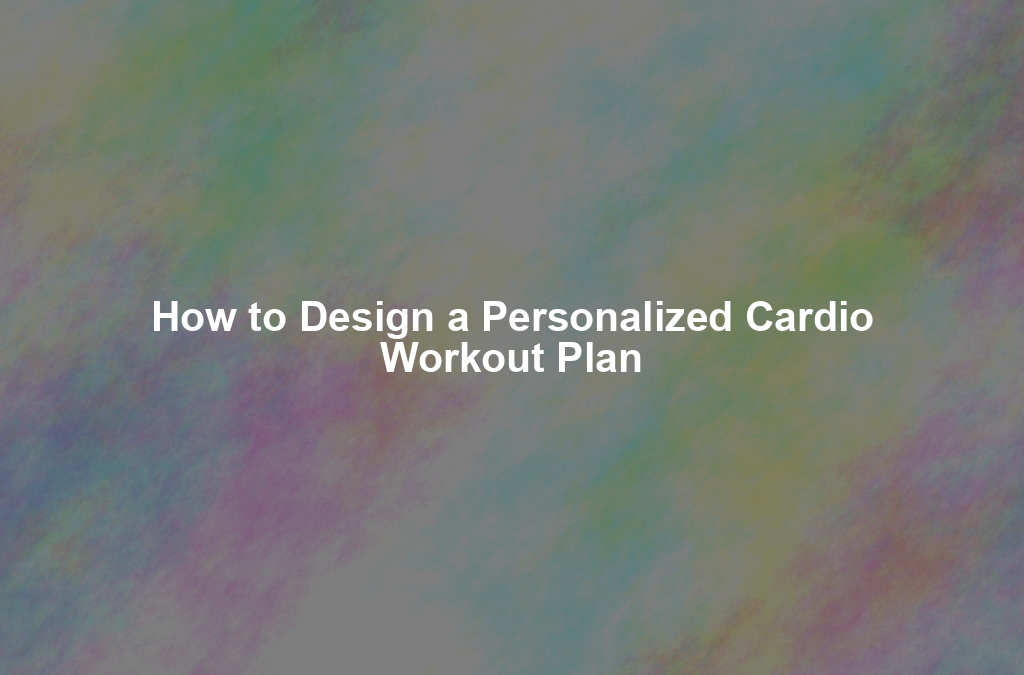
How to Design a Personalized Cardio Workout Plan

A personalized cardio workout plan can transform your fitness journey. Over 50% of adults who exercise regularly follow tailored routines. These plans boost physical fitness by 24% within six months compared to generic workouts. You’ll find increased motivation and satisfaction with progress. Customized programs maintain interest through variety and adaptation. Dive into The Ultimate Guide to Designing Your Cardiovascular Workout Plan and discover how a personalized approach leads to better health outcomes. Start crafting a plan that suits your unique needs today.
The Ultimate Guide to Designing Your Cardiovascular Workout Plan
Understanding Cardio Workouts
Cardio workouts play a crucial role in improving heart health and overall well-being. Regular physical activity can reduce cardiovascular risk factors and enhance heart function. Engaging in cardio exercises helps lower blood pressure and maintain a healthy body weight. Exercise also reduces inflammation throughout the body.
Types of Cardio Exercises
Explore various types of cardio exercises to find what suits you best. Options include:
- Running or Jogging: Great for building endurance.
- Cycling: Offers a low-impact workout.
- Swimming: Engages multiple muscle groups.
- Walking: Simple yet effective for beginners.
- HIIT (High-Intensity Interval Training): Boosts aerobic endurance quickly.
Each exercise type provides unique benefits. Choose activities that align with your preferences and fitness goals.
Benefits of Cardio Workouts
Cardio workouts offer numerous benefits. Regular exercise improves cardiovascular endurance and contributes to overall health. Cardio exercises also enhance immune function and cognitive abilities. Sustained aerobic activities aid in quicker recovery and promote mental clarity.
Assessing Your Fitness Level
Understanding your current fitness level is essential before starting a workout plan. Self-assessment helps set realistic goals and track progress effectively.
Self-Assessment Techniques
Use simple techniques to assess your fitness level:
- Resting Heart Rate: Measure your pulse for a baseline.
- Step Test: Evaluate endurance by timing how long you can step up and down.
- Flexibility Test: Check your range of motion with basic stretches.
These assessments provide insights into your strengths and areas for improvement.
Setting Realistic Goals
Set achievable goals based on your self-assessment. Consider what you want to accomplish with your cardio workouts. Goals might include increasing endurance, losing weight, or improving overall health. Clear objectives keep you motivated and focused.
Remember, The Ultimate Guide to Designing Your Cardiovascular Workout Plan emphasizes gradual progress. Start with manageable goals and adjust as your fitness level improves. Consistency and dedication lead to lasting results.
Designing Your Cardio Workout Plan

Choosing the Right Exercises
Based on Fitness Level
Start by selecting exercises that match your fitness level. Beginners might enjoy walking or cycling. These activities offer a gentle introduction to cardio workouts. Intermediate exercisers can try jogging or swimming. These options provide a moderate challenge. Advanced individuals might explore HIIT or running. These exercises push endurance and strength.
Based on Personal Preferences
Choose exercises you enjoy. Enjoyment keeps motivation high. Love the water? Try swimming. Prefer the outdoors? Go for a run or bike ride. Indoor enthusiasts might prefer treadmill workouts or dance classes. Personal preferences make workouts fun and engaging.
Structuring Your Workout Routine
Frequency and Duration
Decide how often you’ll work out. Aim for at least three times a week. Consistency builds endurance and strength. Each session should last 20 to 60 minutes. Shorter sessions suit beginners. Longer sessions benefit advanced exercisers. Balance frequency and duration for optimal results.
Intensity Levels
Adjust intensity to match your goals. Low intensity suits beginners. It allows gradual adaptation. Moderate intensity works well for most people. It improves cardiovascular health. High intensity challenges advanced exercisers. It boosts endurance and strength quickly. Monitor your heart rate to ensure safe intensity levels.
Case Studies:
- Pre-Made vs. Bespoke Workouts: Studies show bespoke plans outperform pre-made ones. Tailored routines lead to better results. Personalized workouts increase motivation and satisfaction. Pre-made plans lack flexibility. Bespoke plans adapt to changing needs and goals.
Monitoring Progress and Adjusting the Plan
Tracking Your Workouts
Tracking your workouts helps you see progress and stay motivated. You can use different methods to keep tabs on your fitness journey.
Using Fitness Apps
Fitness apps offer a convenient way to track workouts. These apps can log exercises, weights lifted, reps, and sets. Some apps even calculate rest time and provide advanced analytics. You can set goals and receive reminders to stay on track. Fitness apps also allow you to compare results over time. This comparison helps you understand improvements in strength and endurance.
Keeping a Workout Journal
A workout journal provides a personal touch to tracking. You can jot down exercises, sets, and reps after each session. Recording feelings and energy levels can reveal patterns. A journal helps you reflect on what works and what needs adjustment. You can also note body measurements and weight changes. These records show tangible progress and keep you motivated.
Making Necessary Adjustments
Adjusting your workout plan ensures continued improvement. You can tweak intensity and exercises based on your progress.
Increasing Intensity
Increasing intensity challenges your body and boosts fitness. You can add more weight or increase reps in strength exercises. For cardio, try running faster or extending workout duration. High-intensity interval training (HIIT) offers a great way to up the ante. You can monitor your heart rate to ensure safe intensity levels. Gradual increases prevent injury and promote steady progress.
Modifying Exercises
Modifying exercises keeps workouts fresh and effective. You can switch up routines to target different muscle groups. Trying new activities prevents boredom and enhances overall fitness. You can incorporate exercises like swimming or cycling for variety. Modifications help you adapt to changing fitness levels and goals. Personalizing workouts ensures they remain engaging and beneficial.
Tracking progress and making adjustments lead to better results. You can maintain motivation and achieve fitness goals with these strategies.
Tips for Staying Motivated

Setting Milestones and Rewards
Celebrating Achievements
Setting milestones in your workout journey keeps motivation high. Each milestone represents progress and success. Celebrate achievements with small rewards. Treat yourself to a new workout outfit or a relaxing day off. Recognizing progress boosts confidence and enthusiasm.
Rewarding Consistency
Consistency deserves recognition too. Regular workouts build habits and strength. Reward consistent efforts with something enjoyable. Plan a fun activity or a special meal. Consistent actions lead to long-term success and satisfaction.
Finding a Workout Buddy
Benefits of Partner Workouts
A workout buddy adds fun and energy to exercise sessions. Partner workouts create a sense of camaraderie. Shared goals and experiences strengthen bonds. Exercise becomes a social and enjoyable activity.
Accountability and Support
Accountability increases with a workout partner. A buddy encourages commitment and effort. Support from a friend helps overcome challenges. Together, you can achieve fitness goals and stay motivated.
“I found my love and happiness in exercise.” — Harris
Exercise can transform life positively. A workout buddy enhances this journey. Embrace the joy and positivity that come with shared workouts.
Creating a personalized cardio workout plan transforms your fitness journey. Tailored plans ensure exercises match your body and goals, making workouts efficient and enjoyable. Start designing your plan today to experience better results and increased motivation. Consistency and dedication lead to lasting success. Keep pushing forward, celebrate progress, and enjoy the adventure of reaching your fitness goals.


